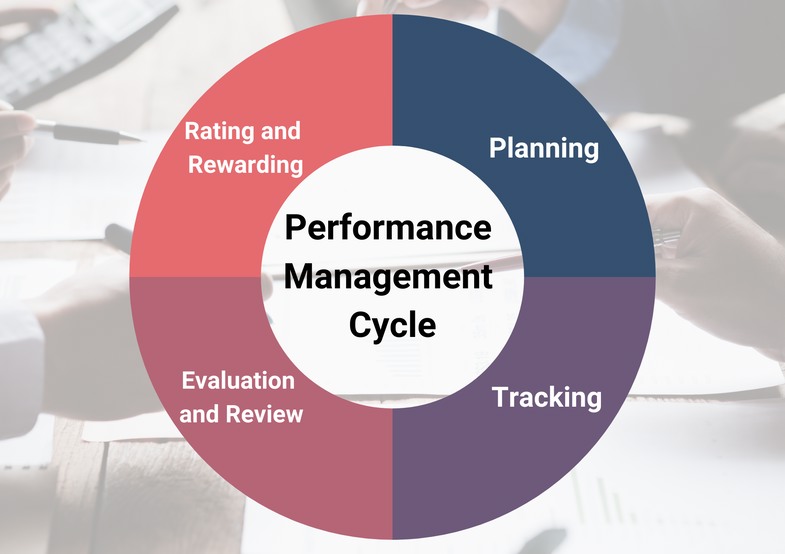Performance management is part of a series of stages in work life. These stages include the recruitment process, job orientation, and some pathways after starting work, such as rotation or promotion. In these processes, employees are often evaluated on their performance to assess them fairly. Performance appraisal is one of these stages.
The first examples of systematic examination and evaluation of employee performance in organizations were seen in the 1900s in public service institutions in the United States. Later, performance appraisal became widespread when Frederick W. Taylor started to measure the productivity of employees through work measurement practices.
Contents
What is Performance Management?
In the business world, performance management has been given equal importance since the period of increased interest in human resource management. Especially with the increase in competition in the private sector, companies are investing more in human resources. In this context, employee performances are evaluated and measures are taken according to the results obtained.
Implemented performance management has enabled companies to be more effective and efficient by increasing the contribution of employees to organizational goals individually, in teamwork, and in their departments.
In short, if we define performance management; it is a systematic process used to increase organizational performance by improving individual and team performance of employees. This process contributes to the maintenance of competitive advantage and the success of businesses.

What are the Performance Management Goals?
Effective performance management is geared towards enhancing employees’ skills and competencies, fostering improved job performance and overall success. The ultimate aim is to assist the organization in attaining its goals.
According to a study conducted by Betterworks, 21% of employees assert that their goals are established annually and subsequently forgotten, with an additional 16% admitting to not setting any goals at all. A significant portion, one-third to be precise, report infrequent one-to-one sessions with managers and limited feedback sessions occurring less than twice a year. Furthermore, 1 in 10 employees claim to rarely or never receive this essential type of feedback.
The primary objectives of performance management encompass defining performance expectations, providing employees with clarity regarding their responsibilities, and elucidating the potential gains tied to meeting these expectations. This can include compensation, rewards, or even promotional opportunities.
Offering continuous, real-time feedback proves instrumental in helping employees comprehend their current standing, facilitating learning, self-correction, and personal growth. The ability to continually refine their job performance not only fosters a sense of accomplishment for the individual but also equips the organization with a highly skilled, engaged, and qualified workforce.
A study by Willis Tower Watson discovered that companies effectively implementing performance management programs are 1.5 times more likely to outperform their financial competitors and 1.25 times more likely to witness an upsurge in employee productivity.
The positive impact of performance management extends to enhancing both individual and team performance, thereby aiding businesses in accomplishing their overarching goals and objectives. For instance, if a business’s objective is revenue growth, the adept management of sales employees’ performance can significantly contribute to achieving this target.
Furthermore, performance management serves as a conduit for employees to recognize the alignment between their personal goals and those of the company. This insight enables them to comprehend their role in achieving organizational goals, fostering engagement and a shared sense of purpose.

Why is Performance Management Important?
By their very nature, companies aim to achieve certain goals. The employees who help them achieve these goals work together by organizing themselves according to their duties and responsibilities. For different companies to come together and form a unity, the working system and success criteria need to be determined correctly.
Performance management is based on people doing work to support each other’s goals. Gradually controlling the contribution of each employee, from small teams to large teams and ultimately to the company’s main objectives, helps the company to achieve its main goals. For this reason, companies are constantly practicing performance management.
When we look at the resources of a company, there are buildings, machinery, finance, and employees. Employees play an important role in adding value to these resources and fulfilling these tasks successfully. Human resources stand out as a critical factor in the success of the company. Employees hired with the right resources must add value to the organization by exhibiting high performance. This management enables the company to achieve its goals.
In order to manage the process effectively, a sustainable and accurate communication between managers and employees is required. Established business plans allow each team to achieve goals for the overall success of the organization. Motivated and engaged employees, regardless of their role and seniority, are aware that they are part of a team and work to contribute to the overall goals.
This practice motivates employees, updates their skills through training organized on the topics they need, and encourages cooperation for harmonious work teams to achieve common goals.

What is The Performance Management Process?
The collaborative nature of the performance management process emphasizes communication between employees and management to strategize, track progress, and evaluate the employee’s goals, career path, and overall impact on the organization.
This ongoing process involves regular feedback sessions where both parties have the chance to share insights and suggestions, fostering a culture of continuous improvement and development within the company.
Research from the Gallup State of the American Workplace report highlights that a mere 22% of employees are actively engaged in their work, underscoring the need for effective performance management practices to boost motivation and productivity across the board.
Identified barriers to engagement include perceived favoritism in promotions, lack of constructive feedback, and exclusion of employees from goal-setting discussions, underscoring the critical role of a well-executed performance management process in driving employee satisfaction and performance.
By implementing a robust performance management system, organizations can address these challenges, empowering employees to excel in their roles and align their objectives with the broader strategic goals of the company.

What is the Performance Management Cycle?
Introduced in 1954 by Peter Drucker, the concept of the performance management cycle is still an effective and valid phenomenon in the industrial context. The performance management cycle includes a description of the following four phases:
1) Planning
Planning is a fundamental action that an organization must address first. Management should set a strategy based on the initial goals that the company aims to achieve, before having a discussion with employees and other team members about goals. Once there is agreement on the organization’s goals, management can set individual goals, overall goals, and specific objectives for teams and employees. When setting goals for teams and employees, it is most effective to plan with them.
In addition to involving employees in the goal-setting process, both parties will discuss training and development goals. Creating a training and development program is important to show employees that you are not only interested in achieving company goals but also in their personal development and career.
2) Tracking
Effective planning and continuous monitoring are key to success. Managers have the responsibility to follow up and monitor the set targets on an ongoing basis. In the past, managers would follow up once or twice a year. Today, however, this approach can be ineffective. Continuous follow-up and feedback mechanisms should be established to solve problems and provide support.
Ideally, monthly or quarterly meetings can be organized. Some organizations even prefer weekly or fortnightly meetings. In addition, deadlines should be flexibly adjusted to take into account unforeseen circumstances or unaccounted-for variables, for example, to accommodate epidemics or new legal regulations.
Identifying problems early and providing the necessary support can only happen effectively under a continuous feedback system. This process is an important step on the road to success and a necessary strategy for optimizing business processes.
3) Evaluation and Review
At the end of the performance management cycle, management conducts an evaluation. If the manager has been successful in the first two cycles, this stage is usually nothing more than a formality. However, in the development phase, the following questions should be asked:
Does the employee have the necessary skills to fulfill his/her task?
How much has he or she learned from the experience? Was the training given at the beginning of the task or during its completion?
Which skills should be focused on to support the learning process?
The development aspect of the third cycle is to assess how far the employee has developed and to identify in which areas they need to be trained.
4) Rating and Rewarding
This is a critical point where management presents performance evaluations to teams and employees. Management should take appropriate action for employees who fail to achieve the set goals. This may include measures such as warnings, fines, or termination if cooperation is impossible. On the other hand, it is extremely important to fairly reward employees who complete their goals. This action shows that the company appreciates and values its employees and is focused on success.
It also sends the message to employees that the organization appreciates their contributions, increasing their motivation. This last cycle is of great importance because if employees do not accept this process, it can negatively affect their motivation. In the worst-case scenario, this can lead to resignation. Also, employees who feel that management will not reward their future efforts can reduce productivity. Once one cycle is completed, it is time to move on to the next performance management cycle.

Performance Management Examples
HSBC
HSBC has introduced a new HR mobile application that enables both employees and managers to efficiently document accomplishments and exchange feedback. Within the app, employees have access to an HR task list, their performance objectives, online training materials, and the ability to update their work details.
Managers can utilize the app to approve requests on the move, establish objectives, and conduct regular check-ins to enhance productivity and foster ongoing development. This application is well-suited for flexible and remote work setups while maintaining high-performance standards.
By using this app, a stronger bond has been formed between managers and employees, leading to increased support for employees and more meaningful year-end evaluations.
Deloitte
Deloitte implemented a trial run of a performance management initiative aimed at fostering regular discussions between team managers and members regarding their performance, priorities, and strengths. Employee surveys were utilized to gain insights from the employees’ viewpoint and enhance the process accordingly.
Individualized career development strategies were devised for all staff members, coupled with the provision of a career mentor to aid in their growth and progress. The utilization of data has proven to be advantageous, especially in assisting underperforming employees in recognizing their standing compared to peers, receiving constructive criticism, and taking necessary steps for improvement.
Furthermore, it has enabled Deloitte to uncover insights into people, team dynamics, and leadership trends that were previously unseen, such as the correlation between the frequency of feedback discussions and employee performance.
IKEA
IKEA aimed to enhance business performance through the enhancement of management and leadership capabilities. To achieve this, they implemented a specialized “train-the-trainer performance management coaching program” for 750 managers and supervisors in the UK. This program consisted of an interactive seminar, coaching skill development in line with the International Coaching Federation standards, certification, and the selection of internal coaching champions.
The departments with managers who participated in the performance management coaching training witnessed a notable improvement in their Key Performance Indicators (KPIs), with a 5% increase. Additionally, their management ability scores surged from 60% to a remarkable 90% across all areas.
Performance Management-Related Videos
We also want to share with you videos about Performance Management. This video answers your questions in the best way. You can click HERE for more videos.
